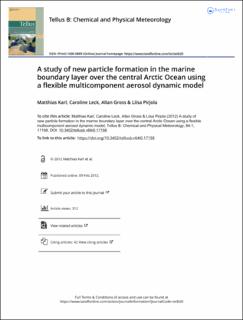A study of new particle formation in the marine boundary layer over the central Arctic Ocean using a flexible multicomponent aerosol dynamic model
Peer reviewed, Journal article
Published version
Permanent lenke
https://hdl.handle.net/11250/2650999Utgivelsesdato
2012Metadata
Vis full innførselSamlinger
- Publikasjoner fra Cristin - NILU [1360]
- Vitenskapelige publikasjoner [1096]
Originalversjon
Tellus. Series B, Chemical and physical meteorology. 2012, 64 . 10.3402/tellusb.v64i0.17158Sammendrag
Enhancement of number concentrations of particles with sizes less than 25 nm diameter has been frequently observed in the boundary layer over the central Arctic Ocean during summer. The sectional aerosol dynamics model for Marine Aerosol Formation (MAFOR) was applied to evaluate the capability of different nucleation mechanisms to reproduce nucleation events observed during three expeditions (1996, 2001 and 2008) onboard the Swedish icebreaker Oden. Model calculations suggest that a source rate of a condensable organic vapour (OV) of about 2×105 cm−3 s−1 is required to reproduce observed growth of nucleation mode particles. Nucleation rates predicted by the newly proposed combined sulphuric acid nucleation mechanism, which best described new particle formation in the Arctic, ranged from 0.04 to 0.1 cm−3 s−1. This mechanism additively combines ion-mediated nucleation and cluster activation, and treats condensation of OV without correction of the Kelvin effect. In several events, the simultaneous number enhancement of particles in the 20–50 nm size range remained unexplained by the nucleation mechanisms. This lends support to alternative theories such as the fragmentation of marine gels (≈200–500 nm diameter in size) by physical or chemical processes.

